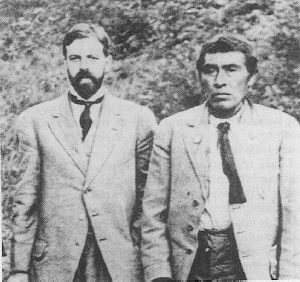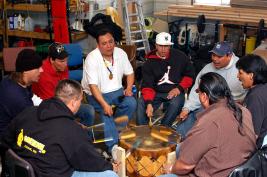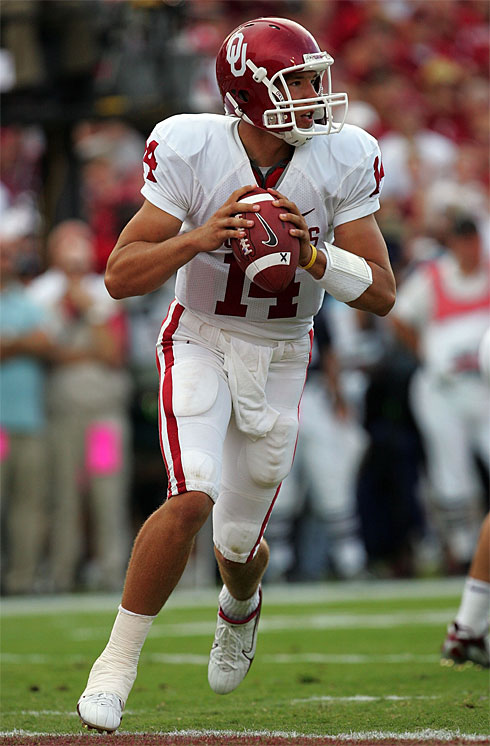An article provides revealing glimpses into life on a troubled reservation:
Native American student shares struggle, dispels stereotypesBy John LonsdaleMurdo is a convergence of checkered white and Native American land in Jones County, S.D.
A town just a half-hour outside of White River, S.D., and 23 miles north of the Rosebud Indian Reservation in Todd County, Murdo is a place where the most common last name isn't Smith but is White Buffalo, Stands And Looks Back or Black Bear.
Renelle White Buffalo, senior in integrated studio arts, was raised by her grandmother and grandfather in this area.And:
Her grandfather moved to a nursing home, and White Buffalo was forced to move in with her alcoholic mother, two brothers and two sisters.
"When I was in high school and middle school, I didn't want to be Native American," White Buffalo said. "I was so bitter about my mom and the bums drinking on the street and all of the bad things that I saw."And:
White Buffalo took over the household—paying the bills and getting her siblings ready for school every day.
"It felt like I was trying to please [my mom] so much," White Buffalo said.And:
Her youngest sister and mother started sending her Happy Birthday cards with hateful messages inside.
"They would say, 'Hey, happy birthday. I hope you...,'" she said, laughing.
White Buffalo and her brother William are the closest. They didn't speak for a year because of their mother, but they are in contact now. Her other brother is upset about how his life has turned out, and neither he nor her younger sister will speak to her.And:
"Res-love" is the term used when women on a reservation have "hickies" and bruises all over their bodies. It's one of the main issues White Buffalo works toward raising awareness for as the only member of the Native American Club this semester.
"People just say, 'That's res-love,'" White Buffalo said. "People make fun of it in order to deal with it and in order to cope. I think that's a huge problem."
It isn't just res-love that was infecting her reservation, though.
"American Indians, as a general rule, live in what contemporary scholars call enforced poverty," Larson said.
Larson, director of American Indian Studies for 11 years, continued.
"They are made to live in greatly diminished circumstances creating the stereotype of the dysfunctional and the savage," he said.
Larson said there is an alcohol problem in many tribal communities, but under the circumstances, any cultural group would most likely medicate itself pretty heavily.
"It's not as simple as they're just all alcoholics," he said. "It's like the stereotype [of American] Indian students getting to go to college for free. It's just not that simple."Comment: White Buffalo was a straight-A student so she managed to go to college, to escape. But look at what she had to endure to get there. An alcoholic mother. Running the household as a teenager. Hate from her siblings. An environment where domestic violence is so common it's laughed at.
White Buffalo had the intelligence to get away from her dysfunctional family. Yet her upbringing was enough to fill her with self-loathing at being an Indian.
Now imagine if she had been a straight-C rather than straight-A student. Or if a parent had abused her. Or if her mother had died and she was sent to a foster home. It wouldn't take much to tip her precarious life from the "win" to the "lose" column.
This is what many young rez Indians endure. It's part of what drives them to
alcohol, drugs, crime, depression, and
suicide. The problem isn't that they're not trying, or that they're "different" from us. It's that they're facing harsh circumstances that most middle-class Americans can't imagine.
To suggest that rez conditions are the "fault" of Indians like White Buffalo is tantamount to racism. Yes, her mother could've gotten help if help was available. But the four White Buffalo children couldn't do much about their circumstances. And so it goes in general. For every adult who may be able to exercise responsibility, there are children, elders, and others who can't. It's not their fault so blaming them is wrong.
Blame system, not victimThe problem is the environment as a whole...the lack of jobs and healthcare...the "enforced poverty." It's the
intergenerational trauma stemming from
broken treaties,
boarding schools, and other forms of
cultural extermination. White Buffalo is only a generation or two away from someone who may have been
tortured for thinking and acting like an Indian.
Her case seems typical to me. Alcoholic and abusive parents pass their dysfunctionality to their children. One or two may survive while the rest succumb. Outsiders
blame the victim without understanding the problem.
This also suggests why Indians
cling to reservations and perpetuate the cycle. For mediocre students who have been abused and lack self-esteem, venturing to a college or city is almost unthinkable. To them this is alien territory, not the natural progression it is for many Americans.
It would be like my going to Russia to change my life. In theory I could do it, but I'd be likely to fail and I'd be too scared to try. I don't have the knowledge or tools to succeed in Russia any more than a troubled Indian teen has what it takes to succeed off the reservation.
The teen could do it with help and training too, of course. But not with platitudes such as "pull yourself up by your bootstraps" or "try harder." That isn't "help," it's the opposite. It's America's rugged individualism aka social Darwinism: Survive on your own or die.
For more on the subject, see
Spirit Level Is Low in US,
Poverty Makes People Sick, and
Intergenerational Trauma = PTSD.
Below: "Renelle White Buffalo, senior in integrated studio arts, works on her drawings at her apartment. She said her art is influenced by her mother, as her mother had a monster just like everyone else, and alcohol fueled her monster and it eventually took over." (Karuna Ang/Iowa State Daily)

























